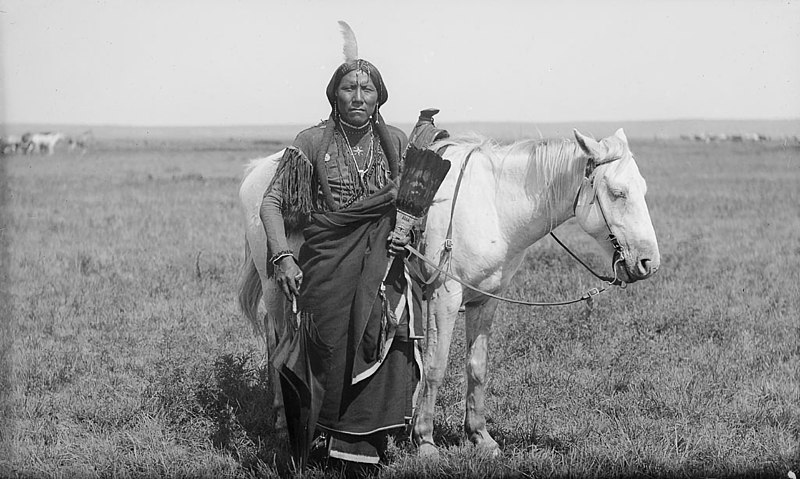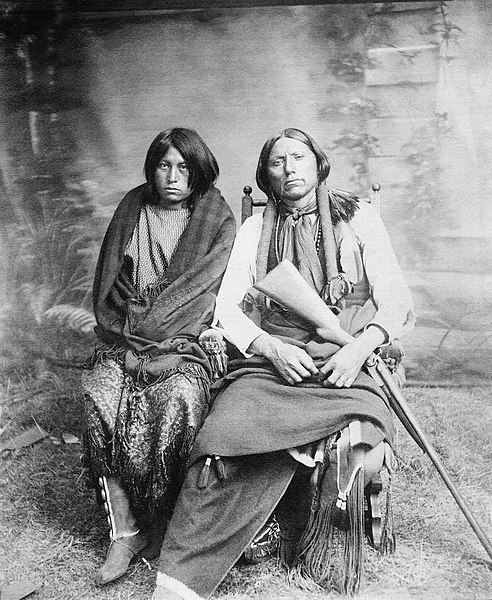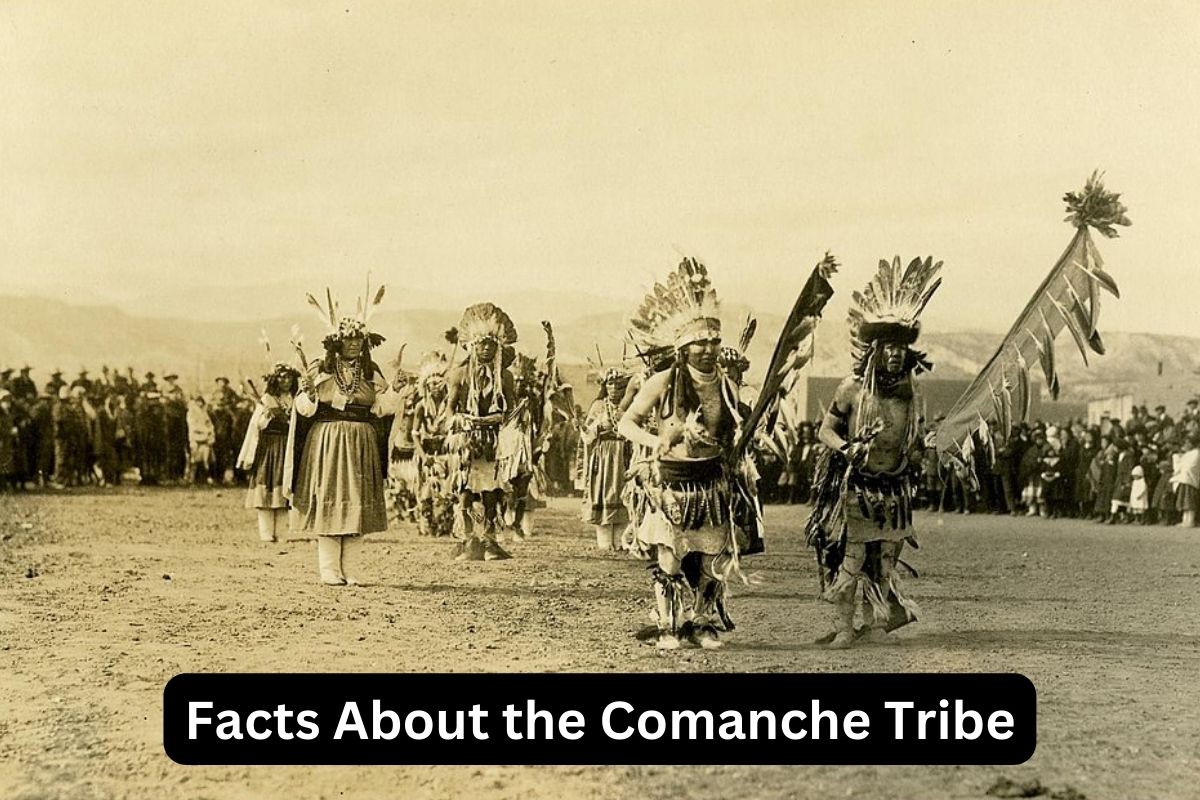The Comanche Tribe, also known as the “Lords of the Plains,” is a Native American tribe with a rich and storied history. Originating in the Great Plains region of North America, the Comanche people were renowned for their exceptional horsemanship, military prowess, and deep connection to the land.
This matrilineal society consisted of several bands, with the Quahadi band, led by Chief Quanah Parker, becoming the most famous. The Comanche Tribe’s traditional territory spanned a vast area, and they lived a nomadic lifestyle, following the buffalo herds for sustenance.
Despite facing challenges from European settlers and the decline of the buffalo, the Comanche people maintain their cultural heritage and continue to play an active role in preserving their traditions today.
Comanche Tribe Facts
1. The Comanche Tribe is a Native American tribe that originated in the Great Plains region of North America
The Comanche Tribe, also known as the “Lords of the Plains,” emerged as a distinct group in the 18th century. They were part of the larger Numic-speaking branch of the Uto-Aztecan language family, which includes other Native American groups such as the Shoshone and Paiute.
Also Read: Facts About the Navajo Tribe
The Comanche people were highly skilled horsemen, and their mastery of horsemanship set them apart from many other tribes in the region. They were known for their exceptional riding skills, which allowed them to excel in warfare, hunting, and transportation.

2. The Comanche people were part of the larger Uto-Aztecan language family
The Comanche language, known as Comanche or Nʉmʉ Tekwapʉ, belongs to the Uto-Aztecan language family. It is a unique and complex language with its own grammar, vocabulary, and linguistic structures.
While the number of fluent speakers has significantly declined over the years, efforts are being made to preserve and revitalize the language through language programs, educational initiatives, and cultural activities.
3. The Comanche Tribe was composed of several bands, with each band having its own leadership and territory
The Comanche Tribe consisted of several bands, each with its own leadership structure and territory. These bands included the:
- Quahadi (Kwahari)
- Nokoni (Nokoniʔ)
- Penateka (Piaʉa)
- Yamparika (Yapʉarʉka)
- Kotsoteka (Kʉhtsʉtshʉka)
Each band was semi-autonomous, with its own leaders and decision-making processes.
The Quahadi band, led by Chief Quanah Parker, became the most famous and influential among the Comanche bands. Quanah Parker was a visionary leader who played a significant role in shaping the history and survival of the Comanche people during a time of immense change and adversity.
The Comanche bands interacted and sometimes clashed with other Native American tribes, such as the Apache and the Kiowa, as well as European settlers and the United States government. Their unique social and political structure allowed them to adapt to the changing circumstances and maintain a level of autonomy for an extended period.
4. The Comanche Tribe’s traditional territory covered a vast area
The Comanche Tribe’s traditional territory spanned a vast area of the Great Plains region, primarily in present-day Texas, New Mexico, Oklahoma, Colorado, and Kansas.
They were a nomadic people, following the seasonal movements of the buffalo herds, which provided them with essential resources for their livelihood. The availability of buffalo dictated their movements, as they relied on the animals for food, clothing, shelter, and tools.
Their nomadic lifestyle allowed the Comanche people to maintain a deep connection with the land and its resources. They had an intricate knowledge of the terrain, water sources, and natural phenomena, which helped them survive in a challenging environment.

5. The Comanche people were skilled hunters and relied heavily on bison for food, clothing, and shelter
The Comanche people were skilled hunters and relied heavily on the buffalo for sustenance. They developed sophisticated hunting techniques and strategies to effectively pursue and kill the massive animals. They used bows and arrows, lances, and later acquired firearms through trade to aid in their hunting endeavors.
Buffalo provided the Comanche with meat for food, hides for clothing, shelter, and trade, bones for tools, and sinew for various purposes. They used every part of the buffalo, ensuring nothing went to waste, and their resourcefulness allowed them to thrive on the Great Plains.
In addition to hunting, the Comanche Tribe engaged in trade with other Native American tribes and later with European settlers. They exchanged goods such as horses, buffalo hides, and agricultural products like corn, beans, and squash for items such as guns, blankets, and metal tools.
6. The Comanche Tribe had a matrilineal social structure, with descent and inheritance passing through the female line
The social structure of the Comanche Tribe was matrilineal, meaning descent and inheritance were traced through the female line. Matrilineal kinship formed the basis of their family and social organization. A person’s clan membership and social status were determined by their mother’s lineage.
Women held significant influence within Comanche society. They played important roles in decision-making, including the selection and removal of tribal leaders. Women owned and managed the family’s property, and their expertise in farming and household affairs contributed to the overall well-being of the community.
Men, on the other hand, played key roles as warriors and hunters. They were responsible for protecting the tribe, participating in intertribal conflicts, and securing resources through hunting and trade. While men held leadership positions, women had the power to influence and guide their decisions.
This matrilineal system ensured a balance of power between genders and fostered cooperation within the community. It also reflected the Comanche Tribe’s deep respect for women and recognized their vital contributions to the tribe’s survival and prosperity.
7. The Comanche people were fierce warriors and engaged in conflicts with neighboring tribes, as well as European settlers
The Comanche people were renowned for their formidable military strength and fierce warrior culture. They engaged in conflicts with neighboring tribes and European settlers who encroached upon their territories. Their warfare tactics and expertise in horsemanship made them a formidable force on the Great Plains.
The Comanche warriors were known for their swift and strategic mounted attacks, which allowed them to strike their enemies with speed and surprise. They were skilled archers and used a variety of weapons, including bows, arrows, lances, and later, firearms acquired through trade.
Their reputation as fierce fighters and their ability to adapt to changing circumstances enabled them to resist Spanish, Mexican, and American attempts to control their lands for several centuries.
8. The Comanche Tribe’s military strength was due in part to their expertise in horsemanship
Horses played a transformative role in Comanche culture. They acquired horses through trade with Spanish colonizers and neighboring tribes, such as the Pueblo and the Apache. The introduction of horses revolutionized their way of life and greatly enhanced their mobility and hunting capabilities.
With horses, the Comanche people were able to cover vast distances quickly, making them more effective hunters and warriors. The ability to hunt buffalo from horseback increased their hunting efficiency and allowed them to access previously unreachable areas. Horses also played a significant role in trade, transportation, and establishing alliances with other tribes.
The Comanche Tribe’s horsemanship skills became legendary, and they became known as some of the finest horsemen in North America. They developed a deep bond with their horses and treated them with great care and respect.
9. The Comanche people had a rich cultural heritage and engaged in various artistic and ceremonial practices
The Comanche people had a rich cultural heritage, which included various artistic and ceremonial practices. They were skilled artisans known for their intricate beadwork, pottery, and buffalo-hide paintings. Comanche beadwork was highly prized and often adorned clothing, moccasins, and ceremonial regalia.
Ceremonies and rituals were an integral part of Comanche life. They celebrated events such as the coming-of-age of young individuals, marriages, and harvests through elaborate ceremonies that included singing, dancing, feasting, and storytelling. The Sun Dance, a prominent ritual among Plains tribes, held deep spiritual significance for the Comanche people.
The Comanche Tribe also had a complex belief system and a close connection to the natural world. They believed in a spiritual realm inhabited by powerful entities and ancestral spirits. Medicine men and women played important roles as spiritual leaders, healers, and intermediaries between the human and spirit realms.
10. With the arrival of European settlers and the decline of the buffalo herds, the Comanche Tribe’s traditional way of life faced significant challenges
With the arrival of European settlers and the decline of the buffalo herds in the late 19th century, the Comanche Tribe faced significant challenges to their traditional way of life. Forced to adapt to changing circumstances, the Comanche people experienced a profound transformation in their history.
As European settlers moved westward, conflicts between the Comanche Tribe and the United States government escalated. The U.S. government implemented policies aimed at assimilation and land consolidation, leading to the establishment of reservations where the Comanche and other tribes were forcibly relocated.
The reservation period marked a major shift in the Comanche Tribe’s lifestyle, as they were confined to limited territories and faced disruptions to their traditional practices.
Despite these challenges, many Comanche descendants today actively work to preserve their cultural heritage, language, and tribal governance. They continue to celebrate their traditions, participate in powwows and other cultural events, and engage in efforts to ensure the continuity of their unique way of life.
